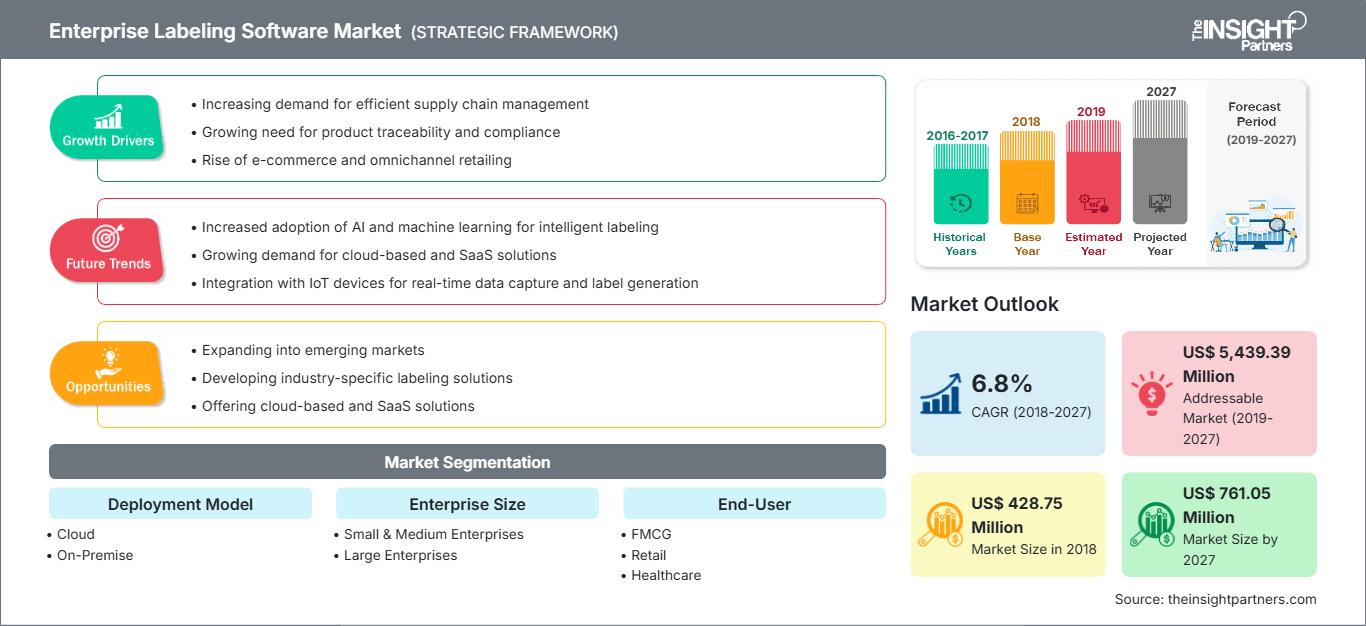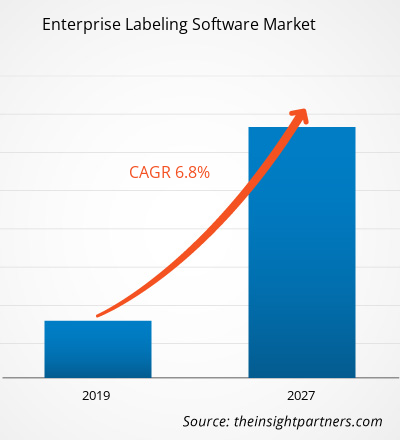市場規模は2024年に4億8,231万米ドルと評価され、2031年までに7億9,995万米ドルに達すると予測されており、2025年から2031年の間に7.8%のCAGRを記録すると予測されています。
エンタープライズラベリングソフトウェア市場分析
エンタープライズラベリングソフトウェア市場は、複数の要因によって大きく形成されています。サプライチェーンの複雑化と厳格な規制要件により、企業は自動化ラベリングソリューションの導入を迫られています。カスタマイズ、統合機能、そしてユーザーフレンドリーなインターフェースは、競争の激しい市場においてベンダーにとって重要な差別化要因となります。取り組むべき主な課題は、多様な業界固有の要件に対応し、レガシーシステムとの互換性を維持することです。さらに、クラウドの導入は、リモートアクセスとスケーラブルな導入を可能にするため、市場に影響を与えています。しかし、購入の決定はデータセキュリティ上の懸念に大きく左右されます。ラベリングソフトウェアプロバイダーとハードウェアメーカーのパートナーシップは、価値提案の魅力を高めるバンドル製品を生み出しています。リアルタイムデータ分析とラベルトレーサビリティに対する顧客ニーズが、継続的なイノベーションを推進しています。
エンタープライズラベリングソフトウェア市場の概要
エンタープライズラベリングソフトウェア市場は、物流、医療、小売、製造など、さまざまな業界のプロセスを合理化する、拡張性に優れた自動化ソリューションを提供しています。これらのソフトウェアは現代の企業の基盤であり、ラベルのデジタル作成、印刷、管理を通じて、企業が精度、適合性、生産性を維持することを可能にしています。エンタープライズラベリングソフトウェア市場は、製造、物流、小売、医療など、さまざまな業界のプロセスを調整するための拡張性に優れた自動化ソリューションを提供しています。これらのソフトウェアソリューションは、企業がラベルをデジタルで作成、印刷、管理できるようにすることで、精度、コンプライアンス、効率性を維持するのに役立ちます。トレーサビリティ、規制遵守、効果的な製品情報管理の需要の高まりを背景に、企業では人的エラーを減らし、業務ワークフローを強化するためにラベリングソフトウェアを導入するケースが増えています。ERPおよびサプライチェーン管理システムとの統合が、このソフトウェアの採用を促進しています。
このレポートの一部、国レベルの分析、Excelデータパックなど、あらゆるレポートを無料でカスタマイズできます。また、スタートアップや大学向けのお得なオファーや割引もご利用いただけます。
エンタープライズラベリングソフトウェア市場:戦略的洞察

- このレポートの主要な市場動向を入手してください。この無料サンプルには、市場動向から見積もりや予測に至るまでのデータ分析が含まれます。
エンタープライズラベリングソフトウェア市場の推進要因と機会
市場の推進要因:
- 規制遵守: 厳格な規制により、製品の安全性と追跡可能性を確保するために、正確で標準化されたラベル付けが求められます。
- サプライ チェーンの複雑さ: 拡大するグローバル サプライ チェーンでは、可視性を維持し、エラーを削減するために、効率的なラベル管理が求められています。
- デジタル変革: 企業は、手動によるラベル付けを置き換え、運用効率を向上させるために自動化ソリューションを導入しています。
市場機会:
- AI と機械学習の統合: AI を組み込むことで、ラベルの精度を高め、ラベル付けプロセスにおけるエラー検出を自動化できます。
- 新興市場への拡大: 新興経済国における工業化の進展により、ラベリング ソリューションの新たな顧客基盤が生まれます。
- IoT 接続: ラベリング ソフトウェアを IoT デバイスに接続することで、リアルタイムの監視とよりスマートなサプライ チェーン管理が可能になります。
エンタープライズラベリングソフトウェア市場レポートのセグメンテーション分析
エンタープライズラベリングソフトウェア市場は、次のように分類されます。
提供内容:
- ソフトウェア: 精度とラベリング手順の自動化のニーズが高まるにつれ、ラベルのデザイン、管理、印刷を簡単に行うことができるより高度なソフトウェア ソリューションの需要が高まっています。
- サービス: 企業は、ソフトウェアを複雑な方法で導入および統合したいという要望に応じて、ソフトウェアの価値を最大限に引き出すために、ソフトウェアをカスタマイズ、実装、サポートできる専門のサービス プロバイダーに目を向けるようになりました。
展開別:
- クラウド: クラウドベースのラベリング ソフトウェアが成長している主な理由の 1 つは、スケーラブルでリモート アクセス可能で、初期コストが低いソリューションを使用する機会を企業に提供するためです。
- オンプレミス:厳格なデータセキュリティとコンプライアンスが求められる企業は、依然としてオンプレミスのアプローチを選択する傾向があります。これにより、ラベルシステムやその他の機密情報に対する完全な管理を維持できます。
エンドユーザー別:
- 日用消費財
- 小売り
- 健康管理
- 倉庫・物流
- 自動車
- 製造業
- その他
企業規模別:
- 中小企業
- 大企業
地理別:
- 北米
- ヨーロッパ
- アジア太平洋
- ラテンアメリカ
- 中東・アフリカ
アジア太平洋地域は、劇的なデジタル変革とサプライチェーンの進化により、世界のエンタープライズラベリングソフトウェア市場の主要なシェアを占める地域となっています。
エンタープライズラベリングソフトウェア市場の地域別分析
予測期間全体を通してエンタープライズラベリングソフトウェア市場に影響を与える地域的なトレンドと要因は、The Insight Partnersのアナリストによって徹底的に説明されています。このセクションでは、エンタープライズラベリングソフトウェア市場のセグメントと地域についても、北米、ヨーロッパ、アジア太平洋、中東・アフリカ、中南米に分けて解説しています。
エンタープライズラベリングソフトウェア市場レポートの範囲
| レポート属性 | 詳細 |
|---|---|
| 2024年の市場規模 | 4億8,241万米ドル |
| 2031年までの市場規模 | 7億9,995万米ドル |
| 世界のCAGR(2025年~2031年) | 7.8% |
| 履歴データ | 2021-2023 |
| 予測期間 | 2025~2031年 |
| 対象セグメント | 提供することで
|
| 対象地域と国 | 北米
|
| 市場リーダーと主要企業の概要 |
|
エンタープライズラベリングソフトウェア市場のプレーヤー密度:ビジネスダイナミクスへの影響を理解する
エンタープライズラベリングソフトウェア市場は、消費者の嗜好の変化、技術の進歩、製品メリットへの認知度の向上といった要因によるエンドユーザー需要の高まりに牽引され、急速に成長しています。需要の高まりに伴い、企業は製品ラインナップの拡充、消費者ニーズへの対応のためのイノベーション、そして新たなトレンドの活用を進めており、これが市場の成長をさらに加速させています。

- エンタープライズラベリングソフトウェア市場のトップキープレーヤーの概要を入手
エンタープライズラベリングソフトウェア市場シェア分析(地域別)
アジア太平洋地域は今後数年間で最も急速に成長すると予想されています。ラテンアメリカ、中東、アフリカの新興市場も、エンタープライズラベリングソフトウェアプロバイダーにとって、事業拡大のための未開拓の機会を数多く提供しています。
エンタープライズラベリングソフトウェア市場は、地域によって成長率が異なります。以下は、地域別の市場シェアとトレンドの概要です。
1. 北米
- 市場シェア: 早期の技術導入と大手企業の存在によりトップ
- 主な推進要因:
- 規制遵守とトレーサビリティに対する高い需要
- 高度なデジタル変革イニシアチブ
- クラウドベースのソリューションの積極的な導入
- トレンド: IoTとAIの統合が進み、よりスマートなラベリングシステムが実現
2. ヨーロッパ
- 市場シェア:厳しい規制環境と産業の多様性により大きく成長
- 主な推進要因:
- 厳格なラベル規制(例:REACH、GDPR)への準拠
- 持続可能性と環境に優しいラベルへの注目の高まり
- 多言語対応やカスタマイズされたラベル作成への高い需要
- トレンド: データセキュリティとローカルコンプライアンスの強化のため、オンプレミスソリューションへの移行
3. アジア太平洋
- 市場シェア:製造業と小売業の拡大に伴い急速に成長
- 主な推進要因:
- 工業化と都市化が需要を加速させている
- クラウドおよびモバイルラベリングソリューションの採用増加
- 世界的な輸出におけるサプライチェーンの可視性の必要性の高まり
- トレンド:新興市場と中小企業へのラベリングソフトウェアの拡大
4. 南米と中央アメリカ
- 市場シェア: 小売業および物流業界からの関心が高まっている成長市場
- 主な推進要因:
- サプライチェーンのトレーサビリティとコンプライアンスの向上の必要性
- 拡大するビジネスをサポートするスケーラブルなクラウドソリューションの導入
- 価格に敏感な市場における費用対効果の高いラベリングソリューションに注力
- トレンド: ローカルベンダーとグローバルソフトウェアプロバイダー間のパートナーシップの拡大
5. 中東およびアフリカ
- 市場シェア: インフラ整備による成長の可能性を秘めた新興市場
- 主な推進要因:
- 成長する物流・製造業
- 業務の非効率性を削減する自動化ソリューションの需要
- デジタル変革に向けた政府の取り組みの強化
- トレンド: コスト効率を高めるためにクラウドベースの導入を段階的に導入
エンタープライズラベリングソフトウェア市場のプレーヤー密度:ビジネスダイナミクスへの影響を理解する
高い市場密度と競争
エンタープライズラベリングソフトウェア市場は熾烈な競争を繰り広げており、Loftware Inc、Seagull Software, LLC、Zebra Technologies Corpといった確立されたグローバル企業が市場をリードしています。また、地域密着型やニッチな企業も進出を拡大しており、様々な地域で競争が激化しています。
この高いレベルの競争により、企業は次のようなものを提供して差別化を図ろうとしています。
- 高度にカスタマイズ可能で業界固有のラベリングソリューション
- シームレスな統合機能
- 強力なサポートとサービスの提供
機会と戦略的動き
- さまざまな分野でクラウド コンピューティングとデジタル変革活動の利用が拡大すると、エンタープライズ ラベリング ソフトウェア市場が拡大する可能性があります。
- ラベリング ソリューションと IoT、AI、高度な分析を組み合わせることで、よりインテリジェントなサプライ チェーン管理と、予測的な方法でのコンプライアンスの監視が可能になります。
- 特にアジア太平洋地域や中東などの新しい地域での成長により、適応性が高く、簡単に拡張できるラベリング ソリューションの必要性が高まっています。
- 医薬品、食品・飲料、物流などの業界の特定のニーズに合わせたソフトウェアの開発により、変化する要件を満たし、カスタマイズされた市場セグメントを開拓します。
エンタープライズラベリングソフトウェア市場で事業を展開している主要企業は次のとおりです。
- テクリンクスコーポレーションSAS
- ユーロソフトプラス
- 株式会社イノバタム
- ロフトウェア株式会社
- ゼブラテクノロジーズ株式会社
- エスコグラフィックスBV
- カリク株式会社
- シーガルソフトウェアLLC。
- アストロノヴァ株式会社
- カルタゴソフトウェアGmbH
注: 上記の企業は、特定の順序でランク付けされているわけではありません。
調査の過程で分析した他の企業:
- 株式会社オールクス
- クリスタルライトソフトウェア
- CYBRA株式会社
- データシステムズインターナショナル(DSI)
- DDi
- エスコグラフィックスBV
- フレイルソフトウェアサービス
- リンシステムズ株式会社
- OPALアソシエイツ・ホールディングAG
- PSIシステムズ株式会社
- RFスマート
- TEC IT データ処理
- タロシステムズ株式会社
- ワスプバーコードテクノロジーズ
- アムテックソフトウェア
エンタープライズラベリングソフトウェア市場のニュースと最近の動向
- BarTenderとMojix、トレーサビリティ革命に向けた戦略的提携を発表 2024年9月、BarTenderとMojixはトレーサビリティ革命を目的とした戦略的提携を発表しました。両社は、よりインテリジェントな意思決定と業務効率の向上のために、比類のない透明性を提供するエンドツーエンドのサプライチェーンソリューションに注力します。
- バーコードおよびRFID追跡ソリューションのリーダーであるCYBRAは、Acumaticaとの戦略的提携を発表しました。2025年1月、バーコードおよびRFID追跡ソリューションのリーダーであるCYBRAは、中小企業の業務効率化を目的としたクラウドベースのERPソフトウェアプロバイダーであるAcumaticaとの戦略的提携を発表しました。この提携により、Acumaticaユーザーは、正確なラベル印刷とリアルタイムのRFID追跡を実現する強力な新オプションを利用できるようになるため、業務の最適化と非効率性の排除が可能になります。
エンタープライズラベリングソフトウェア市場レポートの対象範囲と成果物
「エンタープライズラベリングソフトウェア市場の規模と予測(2021〜2031年)」レポートでは、以下の分野をカバーする市場の詳細な分析を提供しています。
- エンタープライズラベリングソフトウェア市場の規模と予測(スコープに含まれるすべての主要市場セグメントの世界、地域、国レベル)
- エンタープライズラベリングソフトウェア市場の動向、および推進要因、制約、主要な機会などの市場動向
- 詳細なPEST分析とSWOT分析
- 主要な市場動向、世界および地域の枠組み、主要プレーヤー、規制、最近の市場動向を網羅したエンタープライズラベリングソフトウェア市場分析
- エンタープライズラベリングソフトウェア市場の市場集中、ヒートマップ分析、主要プレーヤー、最近の動向を網羅した業界の展望と競争分析
- 詳細な企業プロフィール
- 過去2年間の分析、基準年、CAGRによる予測(7年間)
- PEST分析とSWOT分析
- 市場規模価値/数量 - 世界、地域、国
- 業界と競争環境
- Excel データセット
最新レポート
関連レポート
お客様の声
購入理由
- 情報に基づいた意思決定
- 市場動向の理解
- 競合分析
- 顧客インサイト
- 市場予測
- リスク軽減
- 戦略計画
- 投資の正当性
- 新興市場の特定
- マーケティング戦略の強化
- 業務効率の向上
- 規制動向への対応






















 無料サンプルを入手 - エンタープライズラベリングソフトウェア市場
無料サンプルを入手 - エンタープライズラベリングソフトウェア市場